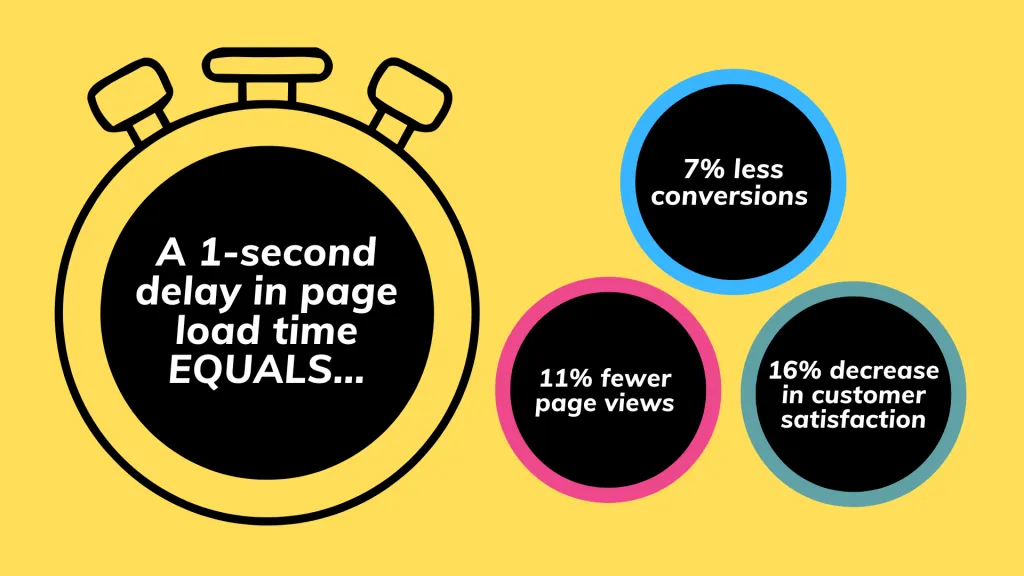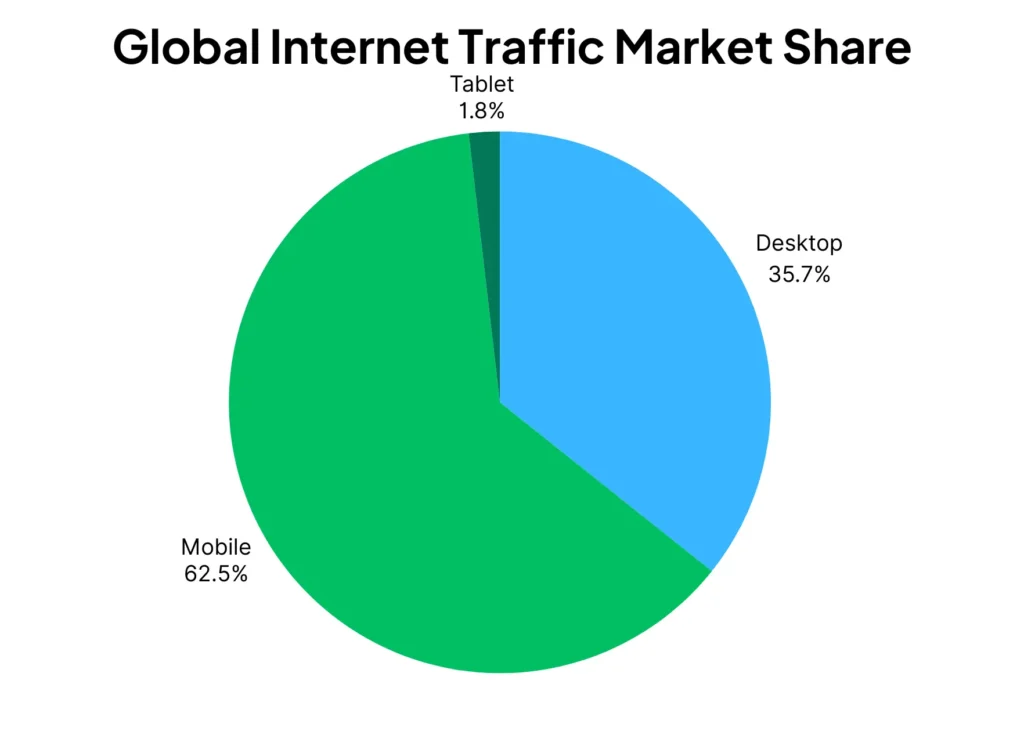Why Fast Pages Beat Pretty Pages

A practical look at why speed matters more than fancy design elements on your website.
We’ll show you real cases where businesses lost money when customers left slow-loading sites… even when those sites had beautiful designs.
You’ll learn how shaving just 1-2 seconds off loading time can mean more sales…
Why big pictures and cool effects often hurt your bottom line…
And the simple fixes that keep both speed and good looks…
We’ll break down exactly how fast your site should be and how to check if yours makes the cut… all without the technical jargon.
A Slow Website Is Costing You More Than You Think
A slow website isn’t just annoying—it’s expensive.
Most businesses think a great-looking website will impress customers.
But if it loads slowly, no one sticks around to see it.
A 1-Second Delay = Lost Revenue. Research from BigCommerce shows that even a 1-second delay in page load time can reduce conversions by 7%.

If your website makes $100,000 per month, that’s $7,000 lost—all because it took an extra second to load.
Amazon Proves That Speed Matters. Amazon found that for every 100ms (a tenth of a second) delay, they lost 1% in revenue.
That means a site making $1 million a day could lose $10,000 daily. If the world’s largest e-commerce company prioritizes speed, so should you.
Your Customers Won’t Wait. Google reports that 53% of mobile visitors leave a page if it takes longer than 3 seconds to load. It doesn’t matter how sleek your design is—if your site is slow, potential buyers are gone before they even see your product.
Aesthetic Choices Can Kill Performance. Big, unoptimized images, fancy animations, and unnecessary effects add seconds to load time. Businesses assume a beautiful design increases engagement. But slow-loading design elements do the opposite.
You Can Fix This, Starting Today. Use Google PageSpeed Insights to measure your load time. If it’s over 2 seconds, start optimizing images, reducing scripts, and using faster hosting.
Speed isn’t just a technical detail—it’s a direct factor in your bottom line.
Slow sites lose customers. Fast sites sell more.
Why Customers Hate Slow Pages (And Google Does Too)
A beautiful website doesn’t matter if no one sticks around to see it.
If a slow website costs you sales, the next question is: Why do customers leave slow pages in the first place? It’s not just impatience… it’s psychology, expectations, and even search rankings working against you.
People Expect Speed, Not Just Looks. When someone visits your site, they expect it to load instantly. A delay—even a fraction of a second—feels like friction. The longer they wait, the more likely they are to leave.
Waiting Feels Like Effort. Research in UX design shows that people associate delays with a poor experience. If your site is slow, visitors assume your service will be slow too. That’s why 79% of online shoppers say they won’t return to a slow website.
Google Punishes Slow Sites. Page speed isn’t just a user experience issue—it affects search rankings too. Google has confirmed that slow-loading pages get pushed down in search results. That means less visibility, fewer visitors, and fewer sales.
Mobile Users Suffer the Most. More than 70% of web traffic comes from mobile, yet many sites are still designed for desktop speeds. Google found that if a mobile page takes longer than 3 seconds to load, over half of users abandon it.

Pinterest’s Speed Win: A 15% Sign-Up Boost. Pinterest made their pages 40% faster and saw a 15% increase in sign-ups. This proves that improving speed doesn’t just prevent losses… it actively drives growth.
The Fix: Prioritize Speed in Your Design. Before adding large images or animations, ask:
Will this slow down my site?
Use lazy loading to prioritize content that loads first and reduce anything that isn’t essential.
Your website isn’t just competing with others in your industry—it’s competing with every fast-loading site your customer has ever visited. Speed isn’t a luxury. It’s an expectation.
The Trade-Off Between Speed and Design (That Shouldn’t Exist)
Many businesses believe they have to choose between a fast website and a beautiful website. But that’s a false choice.
The real goal is a site that looks great and loads in an instant.
The problem?
Many designers and marketers prioritize aesthetics over performance… only to end up driving customers away.
Heavy Design = Slow Performance.
Large background videos… oversized images… and complex animations add unnecessary weight to your site.
While they may look stunning… they slow down the load times, frustrate your users, and hurt your conversions.
The “Wow Factor” Doesn’t Matter If No One Sticks Around. A beautiful homepage means nothing if visitors leave before it loads.
Studies show that users form an impression of a website in 50 milliseconds—but only if they see it in time.
Less Is More (And Faster). Websites with a clean, minimal design often load faster and perform better. Apple’s website is a perfect example—no unnecessary clutter, just speed and usability.
Walmart’s Speed Optimization Playbook. Walmart tested its website performance and found that for every 1-second improvement in load time, conversions increased by 2%. They focused on reducing page bloat while keeping a sleek, user-friendly design.
The Fix: Design With Speed in Mind. Instead of designing first and optimizing later, start with speed as a core principle.
Compress images… remove unnecessary elements… and use lightweight fonts and coding practices to balance beauty and performance.
A fast website isn’t just about technical tweaks—it’s about rethinking design choices to support business goals.
The best websites aren’t just pretty; they’re fast, functional, and built to convert.
The Simple Fixes That Make Any Website Faster
Speeding up your website is easier than you think—if you know where to start.
A slow website isn’t just frustrating—it’s costing you money.
The good news? Most speed problems aren’t caused by deep technical issues.
They come from avoidable mistakes that you can fix with simple changes.
Compress Your Images—Big Files Kill Speed. Large, unoptimized images are one of the biggest culprits of slow load times.
The fix?
Use the WebP format instead of JPEG or PNG and compress images with free tools like TinyPNG.
Cut Out the Excess Code. Every extra plugin, third-party script, or tracking pixel adds weight to your site. Audit your site’s code and remove anything that doesn’t serve a direct business purpose.
Lazy Loading: Show What Matters First. Instead of loading an entire page at once… use lazy loading to prioritize the content that visitors see first.
This helps pages feel instant, even if extra elements load in the background.
Use a Faster Web Host. Cheap hosting may save money upfront, but it costs more in lost sales. A good hosting provider with a fast CDN (like Cloudflare or Fastly) can cut load times dramatically.
How AutoAnything Boosted Revenue by 12%. When AutoAnything optimized their website speed, they saw a 12% jump in sales—without changing a single marketing strategy. Speed alone made the difference.
Test Your Speed and Fix What’s Slowing You Down. Run your site through Google PageSpeed Insights or GTmetrix to identify problem areas. Fix the slowest elements first—small improvements lead to big results.
Your website doesn’t need an expensive redesign—it needs smart optimizations that make it faster and more effective. Because at the end of the day, speed sells.
The Business Impact of a Faster Website
A fast website isn’t just about better user experience—it’s about making more money. Every second you shave off your load time directly impacts conversions, customer trust, and even ad spend.
Speed = More Sales. A 1-second delay can reduce conversions by 7% (BigCommerce). That means if your site makes $100,000 per month, improving speed by 1 second could add $7,000 in revenue—every month.
Better SEO, More Traffic. Google ranks faster websites higher in search results. That means a speed boost doesn’t just increase conversions—it also brings more potential customers to your site.
Lower Bounce Rates = More Engaged Visitors. Studies show that if a page takes longer than 7 seconds, more than half of users leave without taking action. A faster site keeps people engaged and lowers bounce rates.
Faster Checkout = Fewer Abandoned Carts. Slow load times at checkout cause frustration and drop-offs. When Furniture Village improved checkout speed, they saw a 20% decrease in cart abandonment.
Ad Costs Go Down, ROI Goes Up. Facebook and Google charge more per click if your site loads slowly. Faster pages reduce cost per acquisition (CPA), making your marketing dollars work harder.
Faster Websites Build Trust. A slow site feels outdated and unreliable. Speeding up your site signals professionalism, boosting customer confidence and repeat purchases.
Website speed isn’t just a technical issue—it’s a profit multiplier. The faster your site, the more traffic, sales, and ROI you generate.
Fast Pages Win: The Takeaway for Business Owners
A slow website is a silent revenue killer. No matter how beautiful your site is, if it’s slow, you’re losing customers and money. But the good news? Speed is fixable—and the impact is immediate.
First Impressions Matter. Users form an opinion about your site in 50 milliseconds, but only if it loads fast enough to see. A slow site means lost trust before the first click.
Speed Drives Sales and Conversions. Amazon found that every 100ms delay cost them 1% in revenue. Faster pages lead to more leads, more checkouts, and more revenue—without extra ad spend.
You Don’t Have to Sacrifice Design. A fast website can still look great—it just needs smarter optimizations. Compress images, reduce unnecessary code, and use lazy loading to keep performance high.
Faster Pages Boost SEO and Ads. Google rewards fast-loading pages with higher search rankings. Plus, Facebook and Google Ads charge less per click when your pages load quickly.
Small Fixes, Big Results. Simple changes like image compression, better hosting, and script optimization can cut load times by seconds—leading to higher revenue without a full redesign.
Fast Websites Are a Competitive Edge. If your site loads faster than your competitors’, you win more traffic, higher SEO rankings, and more paying customers.
Amazon, Walmart, AliExpress—They All Optimized for Speed. The world’s biggest brands obsess over page speed because they know faster websites make more money. Shouldn’t you?
The Bottom Line: Speed First, Everything Else Second. A fast website isn’t a luxury—it’s a competitive advantage. If your site isn’t optimized, you’re leaving money on the table. Fix it now, or lose customers to faster competitors.
In a world where attention spans are shrinking, the fastest business wins. Is your website built to keep up?
Need help? Send an email to [email protected]
